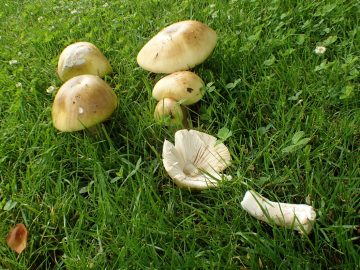In 1987, Paul Kroeger — a mushroom enthusiast of over 35 years and founding member of Vancouver Mycological Society — discovered a previously unidentified mushroom at UBC Botanical Garden. Kroeger and his associate gave the mushroom the name Hypholoma tuberosum. After some research, it turned out that H.tuberosum was not native to B.C. Origins indicated that the source of the mushroom was a nursery in Sydney, Australia, where peat with H.tuberosum was used for potting plants that were sent abroad.

Amanita phalloides. Photo by Adolf Ceska.
Like H.tuberosum, Amanita phalloides mushrooms are also invasive to B.C. Commonly known as death-cap mushrooms, A. phalloides are native to Europe but eventually travelled to North America. Death caps are common in East Vancouver, and in other Vancouver neighbourhoods built in the ‘60s and late ‘70s that contain deciduous trees that came from overseas nurseries. Death-cap mushrooms often have pale greenish or brownish caps and white gills, but can be difficult to spot because they are often hiding underground. Be careful if you happen to stumble upon a death cap, because the poisonous mushroom received its ominous nickname from its ability to induce severe, life-threatening illness.
To read more about invasive mushrooms in B.C., visit The Atlantic.

Hi Bryony,
Thanks for reaching out. The best place to share this information is in our online forums.
I found a fungus in Planta Park in Nanaimo yesterday, which I had never seen before. A friend and I looked on the internet to see what it might be, and it seems it might be urnula pedidiana, and we noted that this fungus was first seen only in 2013, and was unknown before then.I have photos I took of this fungus and I thought someone in your organization might be interested.
Bryony Dunsmore Manders